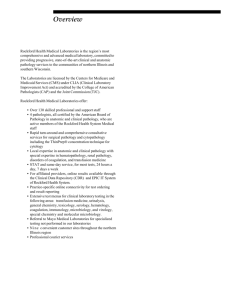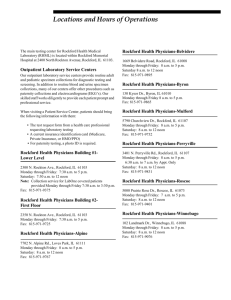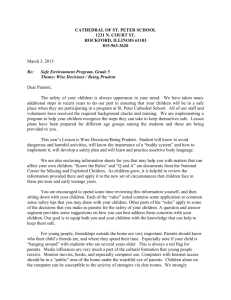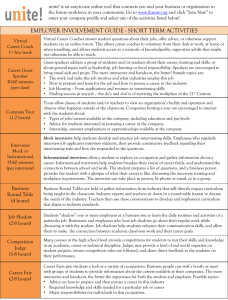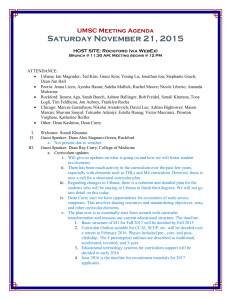WordPress.com
advertisement
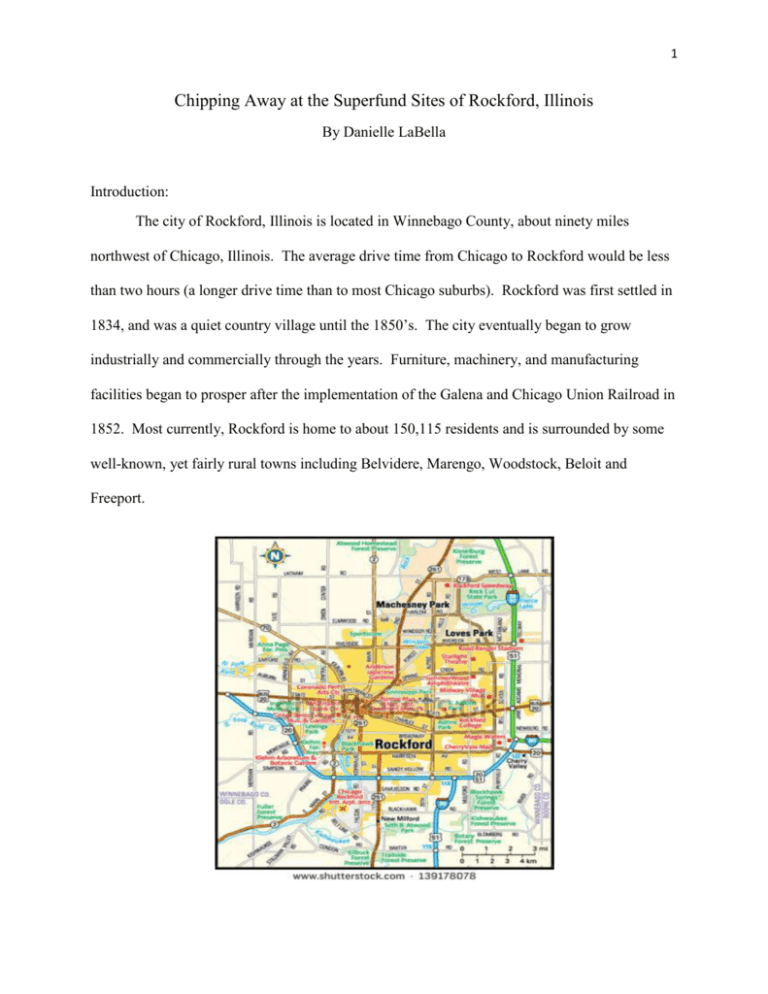
1 Chipping Away at the Superfund Sites of Rockford, Illinois By Danielle LaBella Introduction: The city of Rockford, Illinois is located in Winnebago County, about ninety miles northwest of Chicago, Illinois. The average drive time from Chicago to Rockford would be less than two hours (a longer drive time than to most Chicago suburbs). Rockford was first settled in 1834, and was a quiet country village until the 1850’s. The city eventually began to grow industrially and commercially through the years. Furniture, machinery, and manufacturing facilities began to prosper after the implementation of the Galena and Chicago Union Railroad in 1852. Most currently, Rockford is home to about 150,115 residents and is surrounded by some well-known, yet fairly rural towns including Belvidere, Marengo, Woodstock, Beloit and Freeport. 2 Map of Rockford from www.shuttershock.com The growth of the City of Rockford did not come without consequence, as much urban sprawl resulted from population, technological, industrial, and commercial growth. Within this growth, an era was spawned for Rockford and many other cities. This period of growth included practices that had hazardous consequences for the people of fast-growing cities. Many of these practices forced the initiation of the federal Superfund program, which helps the Environmental Protection Agency (EPA) discover, research, and clean up toxic waste dumps or areas of hazardous contamination. The contamination may involve groundwater, soil or even the air. The main goal of this program is to fund the clean-ups in order to make areas safe for residents, and to make them available for future use. There are three sites located in Rockford, Illinois that are on the current National Priorities List of Superfund sites. The sites are named Pagel’s Pit, Interstate Pollution Control, Inc., and Southeast Rockford Groundwater Contamination. Some of the key reasons these sites are of concern include the history of hazardous waste storage and use as quarries and landfills, and the observation of ground water contamination, soil contamination, and vapor intrusion (hazardous chemicals from contaminated groundwater or soil migrating into an overlying building). All of these locations have seen some clean-up progress, but all have potential longterm hazardous effects. Follow-up studies, including five-year reviews done by the EPA must continue for the crucial ongoing protection of each site and the people of Rockford. Community Profile: Rockford was first settled by Germanicus Kent, Thatcher Blake, and Lewis Lemon from Galena. They first established ground on the west side of the Rock River, as Daniel Shaw 3 Haight settled on the east bank. Rockford is the mid way point between Galena and Chicago, and was first known as “Midway”. The name was quickly changed to Rockford due to the close proximity to Rock River. In 1837, Rockford had a post office, and in 1851, the Rockford Water Power Company was created. By 1852, the Galena and Chicago Union Railroad linked to Rockford. This same year Rockford was chartered a city, spawning the growth of an integral industrial center. The people of Rockford first specialized in furniture-making and agricultural machinery. By the 1960’s, these industries ceased due to the Great Depression and World War II. The new industries of the 20th century shifted towards machine tools, heavy machinery, aerospace technology, fasteners, cabinet hardware products, and automotives. The dawn of and quick demand for these technologies may have led to rash decisions in waste dumping that did not consider the health of the Rockford citizens (Molyneaux, 1997). The first settlers in Rockford came from New England and New York State. Irish and Swedish-born immigrants began to settle in the early 1850’s. The Swedish became the largest ethnic group in the city after the Civil War. Italians were the next large group of immigrants to settle, then the Polish, Lithuanians, Laotians, and Vietnamese. Hispanics did not arrive until decades later, in the 1970’s. Although Lewis Lemon (an African American and former slave) was one of the first settlers of Rockford, it took until after World War I for the black population to make its mark. Most of these settlers came from the south, namely Arkansas and Mississippi. A system for water supply became crucial as development of the city increased. By 1874 a resolution was passed by city council to establish a municipal water supply. By 1881 there were two wells developed due to demand. In 1885, results from studies between well water versus river water showed that the river was much cleaner and free of organic contamination in 4 comparison. The wells were closed, but only for a short time due to the need to provide water at a faster rate. (Pictured is the first deep artesian well in Rockford. Rock River is in the background) An original Pumping Station in Rockford One main water tower in Rockford (All images are from The History of the Rockford Water Division by Thomas Powers) After the Great Depression, urban sprawl and the birth of the baby boomers forced the improvement of water supply systems. By 1970, the water department had thirty-eight operating wells. An elevated tank to store water and control pressure was first used in 1947. In 1985 and 5 1992 two large water towers were built. A third was never built due to opposition of nearby residents. Even through the loss of industry, geographic expansion was cause for the growth of the number of wells in the city. Even when wells were closed for expansion, new ones were built (Powers, 2005). Water supply is an important component of any city, as well as the safety of that water. Time would eventually tell that attention to the activities near water supply stations is imperative to the health of a population because of potential groundwater and soil contamination. The people of Rockford were also actively involved in the anti-slavery and civil rights movements. In time, political campaigns towards these issues, as well as the activation of a military training and drafting center helped establish Rockford as its own developed city. Unfortunately, portions the last thirty years of the 20th century were not promising for Rockford. Tree blight, urban renewal and severe unemployment hit the city hard. By 1989, the people of Rockford were still dealing with racial discrimination and segregation. However, they began to develop institutions of higher learning such as the University of Illinois College of Medicine and Rockford College. Through its ups and downs, Rockford has become the third largest city in Illinois. Many people argue that the demographics of a city can play a role in the decision making process to build hazardous waste facilities or landfills. According to current statistics, whites represent about seventy-two percent of the Rockford population. Blacks represent about seventeen percent, while Hispanics represent only ten percent. The household income in Rockford is almost $20,000 below the median Illinois household income, resting at only $37,363 as of 2012, with per capita income at $21,255. The average house or condo value in 2012 was $95,600, about $80,000 below the Illinois average. About twenty-three and one-half percent of 6 Rockford residents were living in poverty in 2012, with crime rates higher than national average (city-data, 2015). It seems that the current population and the potential long-term effects of contamination play a large role in the need for clean-up. However, the demographics may have played a larger role in creating these sites in the first place. More demographic information including crime rates, education levels, health of residents and drinking water stations with former violations can be found at City-Data.com. List and Discussion of Waste Sites: It appears that the use of the landfills and waste facilities came out of necessity for the city to grow in the early 1900’s, and to maintain growth throughout the 20th century. Most of the Superfund sites are located in the south or southeast end of Rockford, the areas in which much of the industrial work was being done. This seems reasonable considering the industrial boom throughout this time. The issue of ground water contamination and the large population of the city made the Superfund sites of Pagel’s Pit, Interstate Pollution Control and the Southeast Groundwater contamination major priorities for the EPA. Although the demographic statistics of Rockford are not as favorable as in other Illinois cities, the concern for ground water safety and overall health of so many residents was an obvious must, forcing the government to take action for these sites. One site, Pagel’s Pit, is a sand and gravel pit and dolomite quarry that was used as a landfill since 1972 on the southern end of Winnebago County in Rockford. Another Superfund site, Acme Solvent Reclaiming, is located across the road just east of Pagel’s Pit, the latter of which spans over sixty acres of land and is now covered by a coal tar sealer called “blacktop”. The site was open until the land was used to maximum capacity. The landfill accepted wastes 7 such as solvents, municipal refuse and sewage, heavy metals and sewage treatment sludge. It is estimated 120,000 gallons of liquid waste was deposited on this site, as well. A fractured bedrock aquifer is a drinking water source for residents in the area. The flow of the aquifer heads west from Pagel’s Pit. Fortunately, all of these residents are a fair distance from the site. There were some residents on the south east end of the site, but most have fled. The groundwater between Pagel’s Pit and Acme is contaminated with carbon based chemicals called volatile organic compounds, or VOC’s. These chemicals can result in short and long-term health problems including headaches, nausea, dizziness, cancer, and liver or kidney damage (MDH, 2015). Arsenic, chloride, boron and ammonia were also found. Some of the potentially responsible parties (PRP) have helped nearby residents with alternative water sources. The water flowing down-stream received a pump-and-treat system. Additional checks and balances of the system are still necessary to determine the long-term effects of the Superfund clean-up that began in 1991 (Pagel’s Pit, EPA, 2015). These include five-year reviews as well as compliance with institutional controls. These controls help minimize exposure and future contamination by setting standards and limits to actions within hazardous sites. Another site on the Superfund priorities list is the Interstate Pollution Control, Inc. It is located in the south central area of Rockford and was placed on the National Priorities List in 1989. The area of this site was a part of the early industrialization in the 1900’s. Metal casting, machine tooling, plating, textile manufacturing, printing operations and leather tanning were activities common during this time. This site began as a sand and gravel quarry for waste disposal between 1942 and 1972. Between 1974 and 1982, it functioned as a hazardous waste storage facility for about thirty to forty local industry facilities. The reputation of the waste management practices of this site was poor, at best. Unlined impoundment, leaking tanks and 8 drums, and a mixture of incompatible wastes were the norm. Residential, commercial, and industrial wastes all found a home on this site. A quarry also existed below this site in 1918, and once it was filled, it became an auto salvage yard before becoming Interstate Pollution Control. There are many other industrial facilities surrounding this site, including The Gunite Foundry (still in operation), a former pet food plant, and the People’s Avenue Landfill located south of the site. Seventy-three chemicals of potential concern were found in the soil and thirtythree chemicals in the on-site groundwater. Exposure through ingestion or direct contact to these chemicals can be hazardous to human health. Before the Superfund law in 1980, the incinerator was removed from the site and clean-up efforts began due to attention from the Illinois Pollution Control Board. Over 1,400 tons of solid and hazardous waste was removed once the site hit the National Priorities List. All tanks were removed and a clay cover was installed after clearing the site in 1989. More studies were done in 1993 and 1994, with final clean-up actions instated by 1999, with all major clean-up actions completed by 2006. Five-year reviews continue to occur today (Interstate Pollution Control Inc., EPA, 2015). Site Profile: The Southeast Rockford Groundwater site is perhaps the most well-known of all of the sites in Rockford. This site is three miles by two and a half miles located in southeast Rockford. According to the Daily Beast, Rockford is number twenty-three out of twenty-eight for the most contaminated sites in the United States. In 1981, wells in Rockford were found to be contaminated with organic toxins, mostly chlorinated solvents, said to be mostly from dry cleaning and machinery degreasing processes. The ingestion of any of this contaminated ground water could be very harmful to humans. The location was not placed on the National Priorities 9 List until June of 1998. The EPA helped identify the contaminated areas, and private and residential wells were rerouted to the city’s water supply. Over 170 commercial companies in the area compiled about $6 million in 1998 to clean up most of the mess even after the EPA spent millions to study, control and clean the site. Currently, land-use around this location is mostly residential with some industrial and commercial sites. There are about 52,000 residents within one mile of the site. This site involved much more consideration, money and concern from more parties than any of the other sites in Rockford. Attention for the study and clean-up of this site came from state, federal, and potentially responsible parties (PRP). The start-up plan to aid the residents involved providing bottled water. Carbon filters were also installed to filter the drinking water. The site was dissected, then divided into three operable units (ground water, drinking water, and contaminant source control) and four different Source areas called Source area 4, Source area 7, Source area 9/10 and Source area 11. Source area diagrams are provided below. Area 4 (near Harrison Avenue and Marshall Street) Fact Sheet 9a Area 7 (Ekberg Pine Manor Park at the east end of Balsam Lane): 10 Fact Sheet 9b Area 9/10 Fact Sheet 9c Area 11 (northeast corner of Eleventh Street and Harrison Avenue) 11 Fact Sheet 9d Fact Sheet 15 (All Source area images from www.epa.illnois.gov) Plans for clean-up in all areas have been implemented or are still being executed. Hamilton Sundstrand became a lead PRP for most of the area 9/10. Therefore, a consent decree was signed in order to promote action from this responsible party. In 1991, the EPA provided water 12 connection to the municipal water supply for 283 residents and installed a granular activated carbon treatment system on the Rockford Municipal Well #35. The plans as of 1991 and more information can be found here. In 1992, there were an additional 264 homes connected to the municipal water supply as well. By September of 1995, long-term clean-up goals and monitoring of the site was enforced. This also involved the connection of more homes and businesses to municipal water systems. These homes or businesses had potential to exceed health standards or were predicted to exceed these standards within the next seventy years. The major clean-up began once this became an NPL Superfund site in 1998. Over 9,200 feet of iron water mains and an additional 262 municipal hook-ups occurred by June 1999. Nine groundwater monitoring wells were also installed, as well as a groundwater monitoring program for the original groundwater operable unit of contamination. Continuing since 1999, the City of Rockford reports groundwater sampling results to the EPA and Illinois EPA twice a year. More recently, money has been recovered from the funds given by the PRPs and is being used to address four contaminated soil areas in Source Area 7. All source areas are said to be a possible threat to contamination spread. Some tactics to investigate the options for the four major sources included soil vapor extraction, low temperature thermal desorption (use of heat to remove a substance) and soil excavation. These tactics were used in the clean-up of the area affected by Hamilton Sundstrand. Air sparge and soil vapor extraction systems are still currently operating. These systems help to remove contaminant vapors from below ground, for treatment above ground. 13 (From www.epa.illinois.gov Fact Sheet 13A) Groundwater treatment systems for more affected areas have been implemented as recent as 2010. As of 2012, contaminated soil was still a concern and strategies were developed for more clean-up through electrical resistance heating. There is an operating commercial business in this area of the site, and use of the electrical resistance heating technique is supposed to commence in 2015. Another water treatment plant for groundwater clean-up is also said to begin in late 2015/early 2016 for Source Area 7. It seems that continuous attention to this site is a must, and the EPA and Illinois EPA seem to be very aware of this. Both groups have led public meetings during the clean-up process, as well as after Five-Year Reviews. According to the most recent Five-Year Review of June 2013, the level of volatile organic compounds in the wells is causing concern for the risk of vapor intrusion in homes. The review also suggested pore water studies in the Rock River in order to identify ecological impacts of the volatile organic compounds into the river. Pore water is water that occupies spaces between sediment particles, making this water useful for evaluating toxicity and contaminant levels (Pore Water, USGS, 2014). This study was done in 2014 and results are still pending as of February 2015. Once soil vapor evaluations are submitted and approved, the information will be placed on the Southeast Rockford website. Work is continuing 14 through 2015 on all areas of the site and will continue for years to come, but existing residential and commercial properties will remain in use (Southeast Rockford Groundwater Contamination, EPA, 2015). Conclusion: This assignment helps to clarify some of the actions taken by the EPA and Illinois EPA on what is identifiable as a Superfund site and how the process is implemented to study and clean up these sites. It is obvious that some sites get much more attention than others. Most of the sites in Rockford are on the National Priorities List and have received funding and are still in the process of cleaning and maintaining the contamination areas. The use of landfills will not cease at any time, however the ability or desire to identify potential hazards seems more systematic and much more of a concern than in the past. Today, there are more technologies as well as a more detailed system of checks and balances. These systems help to hold people accountable for the hazardous or potentially harmful activities that may occur on a site. The implementation and learning process through the Superfund site program has stimulated these processes. The population of the area helps to keep Rockford a center of attention, as well as the numerous toxins that could lead to potential exposure and health risks to citizens. The desire to keep the people of Rockford informed of progress seems to be important, as people appear to have been involved publicly and locally through public meetings -- not just statewide or nationally. It appears that demographics can be potential reasoning for placement and use of landfills and hazardous sites within the City of Rockford. However, it remains to be seen if more sites will be exposed, and if the current demographic has a great impact on any current hazardous waste malpractice. It is obvious that the sprawl and growth of cities during the industrial past led to actions that had no apparent consequences until contamination was imminent. The 15 important thing is to now rid society of those habits and not just work towards cleaning up past mistakes, but preventing future ones. Bibliography: Molyneaux, J.L. (1997). Rockford IL history. Rockford Public Library. Retrieved April 11, 2015 from http://www.gorockford.com/about-rockford/history/#growing-settlement Powers, Thomas. (2005). History of the city of Rockford water division. Rockford Historical Society. Retrieved April 11, 2015 from http://www.ci.rockford.il.us/public-works/waterdivision/the-water-division.aspx Interstate Pollution Control, Inc. (2015). Retrieved April 10, 2015 from http://www.epa.gov/region5/superfund/npl/illinois/ILT180011975.html Our most polluted states. (2014). The Daily Beast Company. Retrieved April 10, 2015 from http://www.thedailybeast.com/articles/2010/05/19/americas-28-most-pollutedplaces.html Pagel’s Pit. (2015). Retrieved April 10, 2015 from http://www.epa.gov/region5/superfund/npl/illinois/ILD980606685.html Pore water. (2014). USGS. Retrieved April 26, 2015 from http://toxics.usgs.gov/definitions/pore_water.html 16 Rockford, Illinois. (2015). Retrieved April 11, 2015 from http://www.citydata.com/city/Rockford-Illinois.html Southeast Rockford groundwater contamination. (2015). Retrieved April 10, 2015 from http://www.epa.gov/region5/superfund/npl/illinois/ILD981000417.html Volatile organic compounds in your home. (2015). Minnesota Department of Health/MDH. Retrieved April 27, 2015 from http://www.health.state.mn.us/divs/eh/indoorair/voc/

